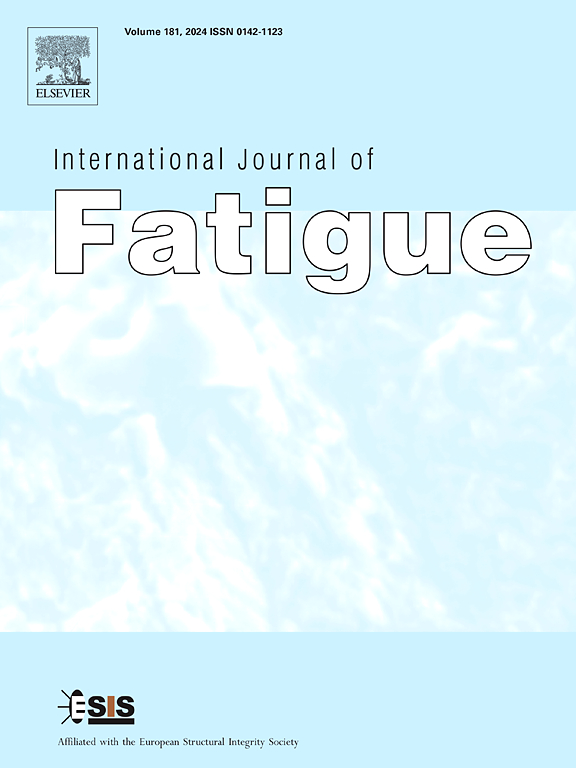An experimental and numerical investigation into tensile fatigue failure of composite laminates containing wrinkles and cut plies
IF 5.7
2区 材料科学
Q1 ENGINEERING, MECHANICAL
引用次数: 0
Abstract
Fibre-reinforced polymer composites are generally seen as more fatigue resistant than metals. However, layup features such as discontinuous plies and/or manufacturing-induced defects such as wrinkles, can initiate fatigue damage and reduce the overall performance of composites. Through an extensive experimental programme and an advanced progressive damage model, this paper investigates the influence of defects and features, both in isolation and in combination, on the tensile static and fatigue performance of quasi-isotropic IM7/8552 laminates. The numerical model describes delamination and intralaminar matrix cracking using cohesive elements that follow a mixed-mode static and fatigue formulation. Experiments and modelling correlate well regarding both the ultimate static strength and S-N curves. The ultimate static strength shows a clear decreasing trend in the order of pristine, wrinkle, cut-ply and combined cut-ply & wrinkle. The cut-ply and wrinkle plus cut-ply show a similar influence on the fatigue life; both are more detrimental than wrinkle. The decrease of the fatigue life due to the defects/features can be up to two decades at a loading level corresponding to half of the pristine ultimate strength. This study implies that, for the IM7/8552 material, a wrinkle in a region of terminating plies does not add significant reduction to fatigue life.
含褶皱和切割层的复合材料层合板拉伸疲劳破坏的实验和数值研究
纤维增强聚合物复合材料通常被认为比金属更耐疲劳。然而,铺层特征,如不连续层和/或制造引起的缺陷,如褶皱,会引发疲劳损伤,降低复合材料的整体性能。通过广泛的实验程序和先进的渐进损伤模型,本文研究了缺陷和特征对准各向同性IM7/8552层压板的拉伸静态和疲劳性能的影响,无论是单独的还是联合的。数值模型描述了分层和层内矩阵的开裂使用内聚元素,遵循混合模式静态和疲劳公式。试验和模型在极限静强度和S-N曲线上有很好的相关性。极限静强度呈明显的递减趋势,依次为原始型、褶皱型、剪层型和复合剪层型;皱纹。剪切层和褶皱加剪切层对疲劳寿命的影响相似;两者都比皱纹更有害。在相当于原始极限强度一半的加载水平下,由于缺陷/特征导致的疲劳寿命下降可达20年。该研究表明,对于IM7/8552材料,在终止层区域的褶皱不会显著降低疲劳寿命。
本文章由计算机程序翻译,如有差异,请以英文原文为准。
求助全文
约1分钟内获得全文
求助全文
来源期刊

International Journal of Fatigue
工程技术-材料科学:综合
CiteScore
10.70
自引率
21.70%
发文量
619
审稿时长
58 days
期刊介绍:
Typical subjects discussed in International Journal of Fatigue address:
Novel fatigue testing and characterization methods (new kinds of fatigue tests, critical evaluation of existing methods, in situ measurement of fatigue degradation, non-contact field measurements)
Multiaxial fatigue and complex loading effects of materials and structures, exploring state-of-the-art concepts in degradation under cyclic loading
Fatigue in the very high cycle regime, including failure mode transitions from surface to subsurface, effects of surface treatment, processing, and loading conditions
Modeling (including degradation processes and related driving forces, multiscale/multi-resolution methods, computational hierarchical and concurrent methods for coupled component and material responses, novel methods for notch root analysis, fracture mechanics, damage mechanics, crack growth kinetics, life prediction and durability, and prediction of stochastic fatigue behavior reflecting microstructure and service conditions)
Models for early stages of fatigue crack formation and growth that explicitly consider microstructure and relevant materials science aspects
Understanding the influence or manufacturing and processing route on fatigue degradation, and embedding this understanding in more predictive schemes for mitigation and design against fatigue
Prognosis and damage state awareness (including sensors, monitoring, methodology, interactive control, accelerated methods, data interpretation)
Applications of technologies associated with fatigue and their implications for structural integrity and reliability. This includes issues related to design, operation and maintenance, i.e., life cycle engineering
Smart materials and structures that can sense and mitigate fatigue degradation
Fatigue of devices and structures at small scales, including effects of process route and surfaces/interfaces.
 求助内容:
求助内容: 应助结果提醒方式:
应助结果提醒方式:


